GENERAL NONDISCRIMINATION REQUIREMENTS
Policies and Procedures
Your business, like all others, has formal and informal policies, practices, and procedures that keep it running smoothly. However, sometimes your policies or procedures can inadvertently make it difficult or impossible for a customer with a disability to access your goods and services. That is why the ADA requires businesses to make “reasonable modifications” to their usual ways of doing things when serving people with disabilities. Most modifications involve only minor adjustments in policies. For example, a day care center that has two scheduled snack times must modify this policy to allow a child with diabetes to bring food for an extra snack if necessary. A clothing store must modify a policy of permitting only one person at a time in a dressing room for a person with a disability who is shopping with a companion and needs the companion’s assistance to try on clothes. Anything that would result in a “fundamental alteration” —a change in the essential nature of your business—is not required. For example, a clothing store is not required to provide dressing assistance for a customer with a disability if this is not a service provided to other customers.
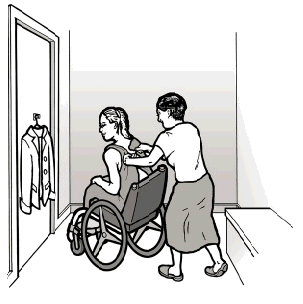
Allowing a second person in a dressing room is one way to modify policies.
Customers with disabilities may need different types of assistance to access your goods and services. For example, a grocery store clerk is expected to assist a customer using a mobility device by retrieving merchandise from high shelves. A person who is blind may need assistance maneuvering through a store’s aisles. A customer with an intellectual disability may need assistance in reading product labels and instructions. Usually the customer will tell you up front if he or she needs assistance, although some customers may wait to be asked “may I help you?” When only one staff person is on duty, it may or may not be possible for him or her to assist a customer with a disability. The business owner or manager should advise the staff person to assess whether he or she can provide the assistance that is needed without jeopardizing the safe operation of the business.
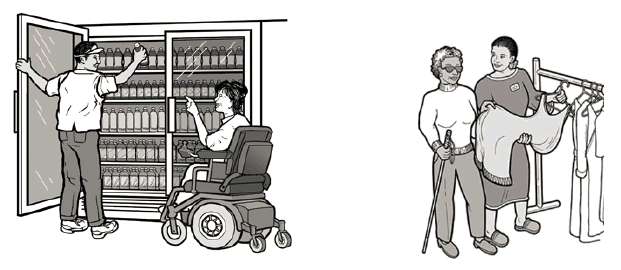
Retrieving out of reach items and describing items for sale are ways to provide assistance to customers with disabilities.
Service Animals
Often businesses such as stores, restaurants, hotels, or theaters have policies that can exclude people with disabilities. For example, a “no pets” policy may result in staff excluding people with disabilities who use dogs as service animals. A clear policy permitting service animals can help ensure that staff are aware of their obligation to allow access to customers using service animals. Under the ADA’s revised regulations, the definition of “service animal” is limited to a dog that is individually trained to do work or perform tasks for an individual with a disability. The task(s) performed by the dog must be directly related to the person’s disability. For example, many people who are blind or have low vision use dogs to guide and assist them with orientation. Many individuals who are deaf use dogs to alert them to sounds. People with mobility disabilities often use dogs to pull their wheelchairs or retrieve items. People with epilepsy may use a dog to warn them of an imminent seizure, and individuals with psychiatric disabilities may use a dog to remind them to take medication. Service members returning from war with new disabilities are increasingly using service animals to assist them with activities of daily living as they reenter civilian life. Under the ADA, “comfort,” “therapy,” or “emotional support” animals do not meet the definition of a service animal.
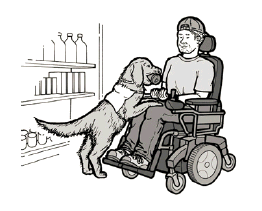
Service animals provide many types of assistance for people with disabilities.
Under the ADA, service animals must be harnessed, leashed, or tethered, unless these devices interfere with the service animal’s work or the individual’s disability prevents him from using these devices. Individuals who cannot use such devices must maintain control of the animal through voice, signal, or other effective controls. Businesses may exclude service animals only if 1) the dog is out of control and the handler cannot or does not regain control; or 2) the dog is not housebroken. If a service animal is excluded, the individual must be allowed to enter the business without the service animal.
In situations where it is not apparent that the dog is a service animal, a business may ask only two questions: 1) is the animal required because of a disability and 2) what work or task has the animal been trained to perform? No other inquiries about an individual’s disability or the dog are permitted. Businesses cannot require proof of certification or medical documentation as a condition for entry [sic]
Wheelchairs and Other Power-Driven Mobility Devices
People with mobility, circulatory, or respiratory disabilities use a variety of devices for mobility. Some use walkers, canes, crutches, or braces while others use manually-operated or power wheelchairs, all of which are primarily designed for use by people with disabilities. Businesses must allow people with disabilities to use these devices in all areas where customers are allowed to go.
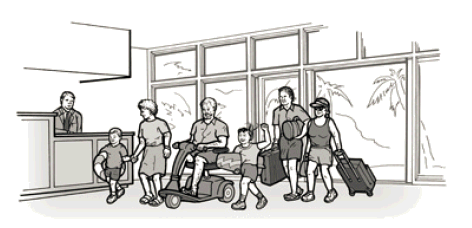
Devices categorized as wheelchairs must be permitted.
Advances in technology have given rise to new power-driven devices that are not necessarily designed for people with disabilities, but are being used by some people with disabilities for mobility. The term “other power-driven mobility devices” is used in the revised ADA regulations to refer to any mobility device powered by batteries, fuel, or other engines, whether or not they are designed primarily for use by individuals with mobility disabilities for the purpose of locomotion. Such devices include Segways®, golf cars, and other devices designed to operate in non-pedestrian areas. Public accommodations must allow individuals who use these devices to enter their premises unless the business can demonstrate that the particular type of device cannot be accommodated because of legitimate safety requirements. Such safety requirements must be based on actual risks, not on speculation or stereotypes about a particular class of devices or how they will be operated by individuals using them.
Businesses must consider these factors in determining whether reasonable modifications can be made to admit other power-driven mobility devices to their premises:
- The type, size, weight, dimensions, and speed of the device;
- The business’s volume of pedestrian traffic (which may vary at different times of the day, week, month, or year);
- The business’s design and operational characteristics, such as its square footage, whether it is indoors or outdoors, its placement of stationery equipment or devices or furniture, and whether it has storage space for the device if requested by the customer;
- Whether legitimate safety standards can be established to permit the safe operation of the device; and
- Whether the use of the device creates a substantial risk of serious harm to the environment or natural or cultural resources or poses a conflict with Federal land management laws and regulations.
Using these assessment factors, a business may decide that it can allow devices like Segways® in its facilities, but cannot allow the use of golf cars in the same facility. It is likely that many businesses will allow the use of Segways® generally, although some may decide to exclude them during their busiest hours or on particular shopping days when pedestrian traffic is particularly dense. Businesses are encouraged to develop written policies specifying when other power-driven mobility devices will be permitted on their premises and to communicate those policies to the public.
Businesses may ask individuals using an other power-driven mobility device for a credible assurance that the device is required because of a disability. An assurance may include, but does not require, a valid State disability parking placard or other Federal or State-issued proof of disability. A verbal assurance from the individual with a disability that is not contradicted by your observation is also considered a credible assurance. It is not permissible to ask individuals about their disabilities.
Communicating with Customers
Communicating successfully with customers is an essential part of doing business. When dealing with customers who are blind or have low vision, those who are deaf or hard of hearing, or those who have speech disabilities, many business owners and employees are not sure what to do. The ADA requires businesses to take steps necessary to communicate effectively with customers with vision, hearing, and speech disabilities.
Because the nature of communications differs from business to business, the rules allow for flexibility in determining effective communication solutions. What is required to communicate effectively when discussing a mortgage application at a bank or buying an automobile at a car dealership will likely be very different from what is required to communicate effectively in a convenience store. The goal is to find practical solutions for communicating effectively with your customers. For example, if a person who is deaf is looking for a particular book at a bookstore, exchanging written notes with a sales clerk may be effective. Similarly, if that person is going to his or her doctor’s office for a flu shot, exchanging written notes would most likely be effective. However, if the visit’s purpose is to discuss cancer treatment options, effective communication would likely require a sign language or oral interpreter because of the nature, length, and complexity of the conversation. Providing an interpreter guarantees that both parties will understand what is being said. The revised regulations permit the use of new technologies including video remote interpreting (VRI), a service that allows businesses that have video conference equipment to access an interpreter at another location.
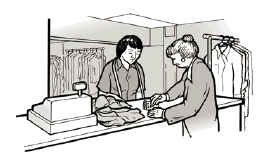
Exchange of written notes may be appropriate for casual interactions.
It is a business’s responsibility to provide a sign language, oral interpreter, or VRI service unless doing so in a particular situation would result in an undue burden, which means significant difficulty or expense. A business’s overall resources determine (rather than a comparison to the fees paid by the customer needing the interpreter) what constitutes an undue burden. If a specific communications method would be an undue burden, a business must provide an effective alternative if there is one.
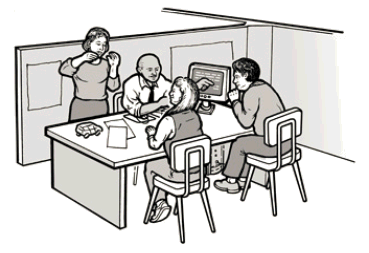
Complex transactions will likely require more formal means of communication, such as a sign language interpreter.
Many individuals who are deaf or have other hearing or speech disabilities use either a text telephone (TTY) or text messaging instead of a standard telephone. The ADA established a free telephone relay network to enable these individuals to communicate with businesses and vice versa. When a person who uses such a device calls the relay service by dialing 7‒1‒1, a communications assistant calls the business and voices the caller’s typed message and then types the business’s response to the caller. Staff who answer the telephone must accept and treat relay calls just like other calls. The communications assistant will explain how the system works if necessary.
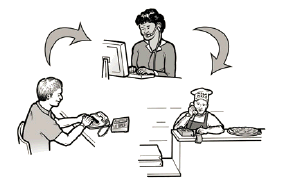
Businesses must answer calls placed through the telephone relay service.
The rules are also flexible for communicating effectively with customers who are blind or have low vision. For example, a restaurant can put its menu on an audio cassette or a waiter can read it to a patron. A sales clerk can find items and read their labels. In more complex transactions where a significant amount of printed information is involved, providing alternate formats will be necessary, unless doing so is an undue burden. For example, when a client who is blind visits his real estate agent to negotiate the sale of a house, all relevant documents should be provided in a format he can use, such as on a computer disk or audio cassette. It may be effective to e-mail an electronic version of the documents so the client can use his or her screen-reading technology to read them before making a decision or signing a contract. In this situation, since complex financial information is involved, simply reading the documents to the client will most likely not be effective. Usually a customer will tell you which format he or she needs. If not, it is appropriate to ask.
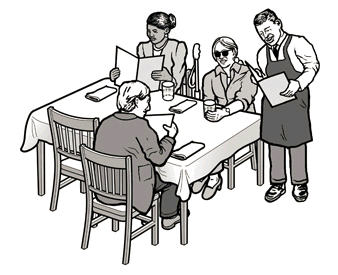
Reading a menu to a customer who is blind is one way to provide effective communication.

User Comments/Questions
Add Comment/Question